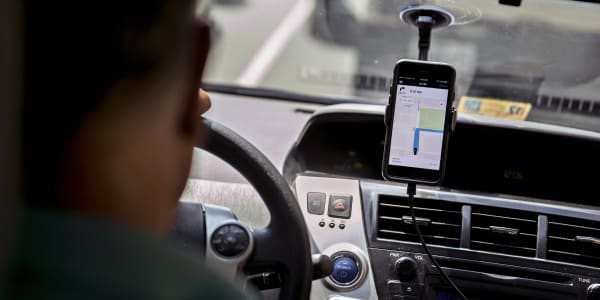Up to $80 billion is spent annually across the U.S. to confront child abuse and neglect, an ugly underside of American life that afflicts hundreds of thousands of children.
Los Angeles County, with the largest child protective services agency in the country, believes there has to be a better way to protect at-risk youth than the current outdated and costly approach. LA County is piloting the use of predictive analytics technology — informally known as big data — from Cary, North Carolina-based software company SAS, to do a better job of identifying children who may otherwise be left in a vulnerable position.
For professionals working in child protective services, it remains difficult and frustrating to use the frequency of calls about suspected abuse to identify which children are living at a high level of risk.
"We put a man on the moon in a 10-year period, and yet we haven't been able to identify a tool to help us in the child welfare industry," said Philip Browning, director of the Department of Children and Family Services (DCFS) in Los Angeles County.

In 2013, about 3.5 million reports were made to child protective services concerning the safety and well-being of approximately 6.4 million children, according to federal government data. A nationally estimated 679,000 children were found by the federal government to be victims of child abuse or neglect.
An estimated 1,520 children died due to abuse or neglect in 2013, the most recent year for which the data is available. Of these, 71.4 percent suffered neglect and 46.8 percent suffered physical abuse and other forms of maltreatment.
Browning is betting that the LA child welfare agency's $2 billion budget will more effectively serve its caseworkers and help the 36,000 children in LA County at risk — and save millions of dollars — by adopting the big data tool.
Paula Henderson, vice president of the SAS state and local government practice, said there is approximately $270 million across the U.S. in state budgets and federal matching dollars devoted to child welfare research, data collection and analysis.
"It's likely that projects would be funded from that," Henderson said, "but as more value is realized, budget priorities will shift accordingly and the market will grow."
Scoring at-risk children
Players across the tech and consulting landscape are chasing the predictive analytics opportunity in the government sector — including IBM, SAS and Deloitte — and smaller companies, like Philadelphia-based Algorhythm and Florida-based Eckerd, are creating solutions for the child welfare services market, specifically.
To monitor at-risk children, "Typically, anywhere from six to 10 government agencies would be enough to establish a pretty accurate risk score," said Greg Henderson, director, SAS Security Intelligence, who demonstrated the company's technology exclusively for CNBC.
Instead of case agents having to pick up the phone and call various government agencies to find out more information about the child in question, SAS is streamlining the process by retrieving all the relevant statistics from various government agencies — departments of health, education and corrections, for example — and then importing that information into one database.
Data points that appear to be atypical — like a child visiting an emergency room and switching schools often — would raise red flags for the case agent. There would also be information about the child's family, since experts say that whoever is living with the child has a big, if not the greatest, influence on his or her well-being. The SAS tool provides a total risk score for each child based on numerous factors, as well as a map of that child's social network and data points related to those connections, such as criminal history.
(Note: The demo screen above provided exclusively to CNBC by SAS does not use the names or addresses of actual CPS clients. It is a mock-up of how the predictive analytics technology will map social connections. Any correspondence to names of real individuals or actual Los Angeles County CPS client addresses is purely coincidental.)
Against the odds
The approach has not been universally supported. Critics say rather than protect children and save money, adoption of predictive analytics would mean lucrative contracts for tech companies but could lead to racial profiling and predatory behavior on the part of case agents.
"Kids deserve better than to be exploited by a piece of software that's providing (at least in their mind) a prediction that we think should be provided by the community itself," said Los Angeles community activist and executive director of Project Impact, Matthew Harris.
His fundamental concern about big data is its top-down approach. "The problem with big data, especially in Los Angeles County, is that the pockets of success get overlooked and buried or aggregated by the big data," Harris said. "Big data can point to the problems of race disparity ... but come to my neighborhood and I'll show you what I'm doing about it and how our kids are succeeding against the odds. Replicating neighborhood success from the bottom up is where we improve the system," he added.
Browning said it's easy to make the argument that predictive analytics boils down to a banker looking at a FICO score and nothing more, but he said it's a flawed critique.
"The banker takes that [score] into consideration but doesn't automatically eliminate you … And our workers will do the same thing. They'll try to find out what the real story is. But this will be an indicator that they could use," Browning said.
Kids deserve better than to be exploited by a piece of software.Matthew HarrisLos Angeles community activist and executive director of Project Impact
Emily Putnam-Hornstein, an assistant professor at the USC School of Social Work, said the adoption of predictive analytics is not likely to be reversed. She pointed to use among private companies across industries — whether it's Visa or Chevron — and state and federal entities.
Putnam-Hornstein cited other areas in criminal justice — in particular, juvenile courts — where experts are beginning to devise and roll out risk-assessment tools, such as for pre-hearing sentencing decisions.
Nonprofit Prevent Child Abuse America estimates that the $80 billion spent annually on child abuse and neglect works out to $220 million per day.
Browning said that beyond the state budget, "there's a huge amount of money at the federal level that goes for child welfare." The estimate of nearly 700,000 children who are abused or neglected across the country comes from the U.S. Department of Health and Human Services.
If the software proves successful in identifying a child's level of risk, Browning said it would be up for a competitive bidding process.
Henderson said SAS has invested "a few million dollars" to build the risk-assessment software for LA County. The software company expects potential revenue from selling a successful model into the market to reach tens of millions of dollars.
Wade Horn, a director with Deloitte's public sector practice, said via email that the cost of running child protective services agencies across the country, which runs into the billions of dollars, is what makes this an attractive opportunity for predictive analytics solutions, which are relatively inexpensive.
In a parallel public sector development, Deloitte noted in a recent publication that several U.S. states either have implemented or intend to implement predictive models designed to help child support enforcement officers identify noncustodial parents at risk of falling behind on their child support payments. IBM has an analytics unit devoted to the government sector, from crime prevention to social programs.
"From a business perspective, I think there's a huge market," Browning said, adding, "Every county and every state in this country has a need for something to do a better job with their child welfare program."
But while the tech firms and bureaucrats envision a better future powered by data, Harris said his focus remains on human connections: "People that develop relationships with these kids, those are the folks that are in a unique position to be able to predict the future of these kids," he said.








